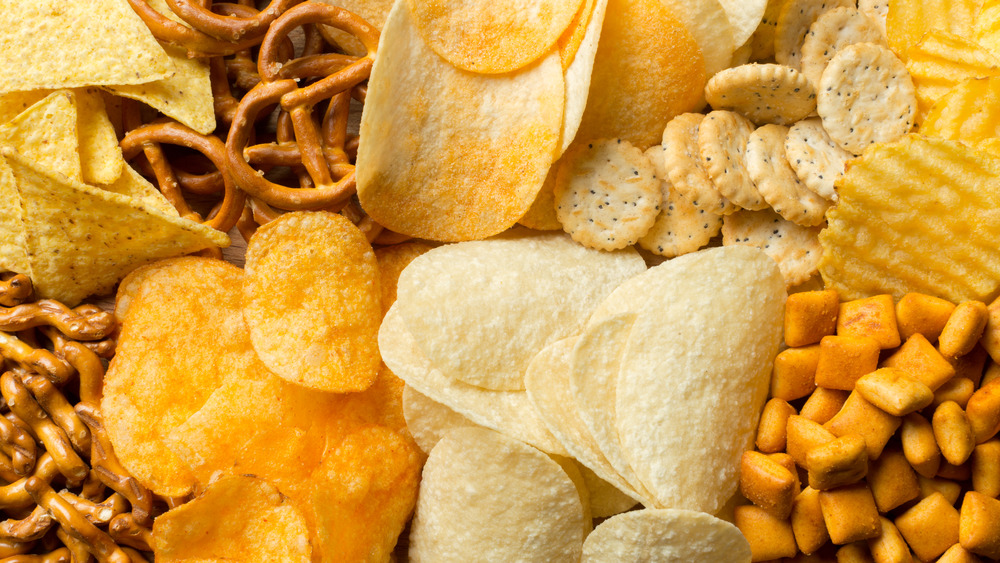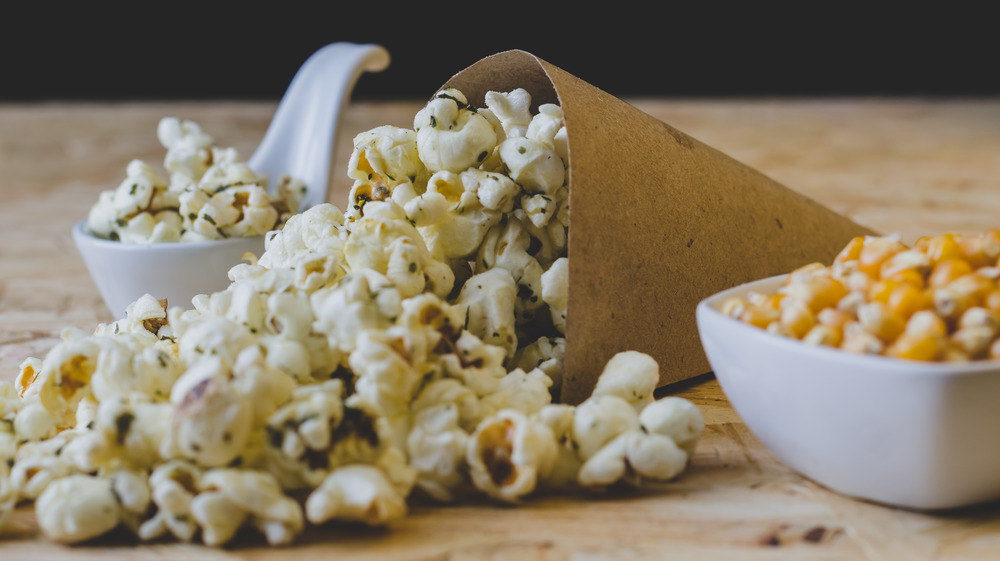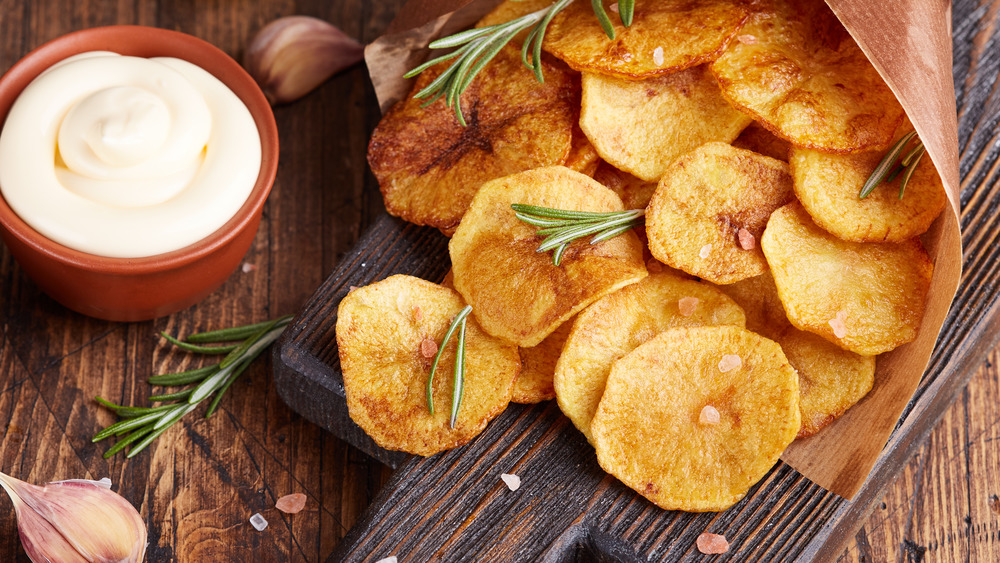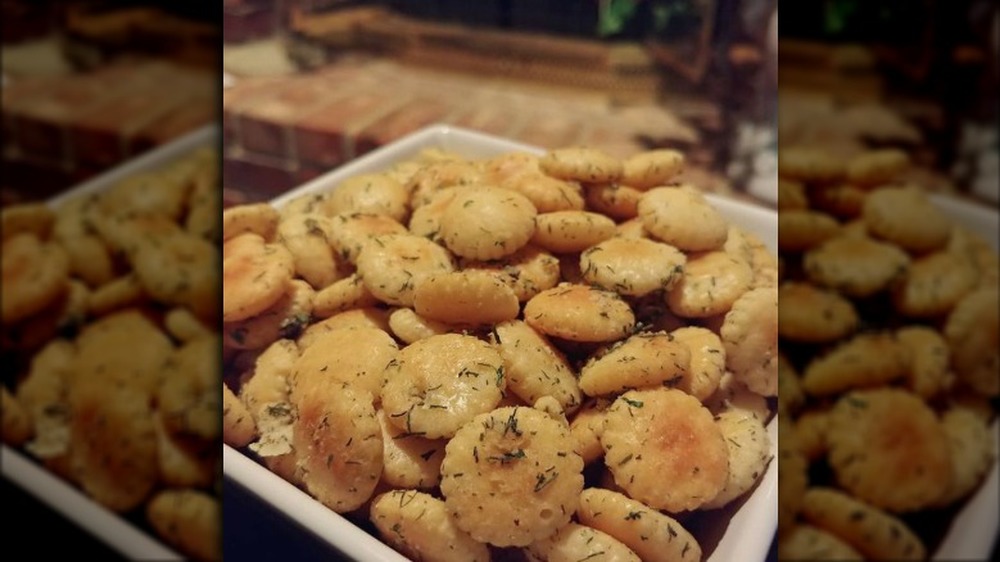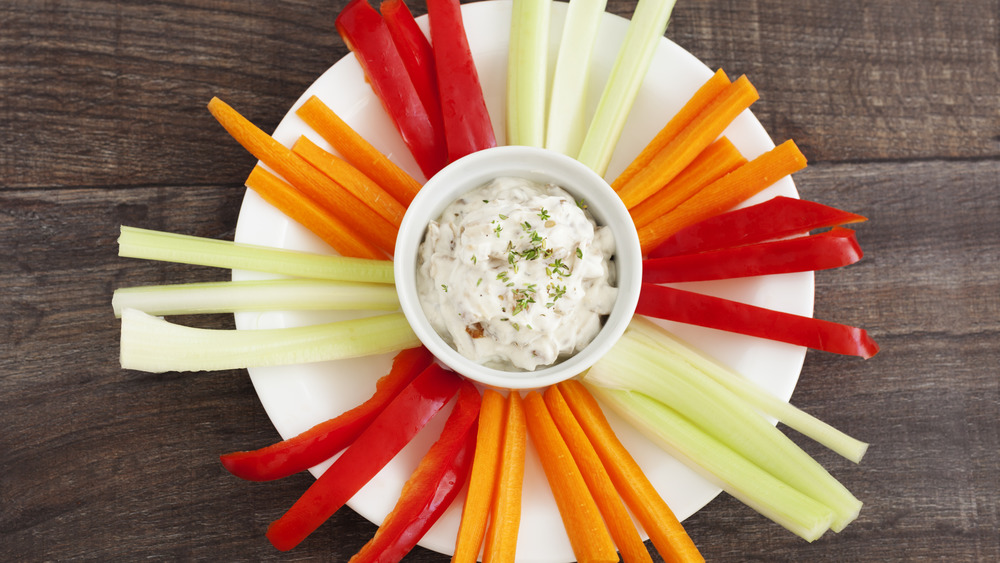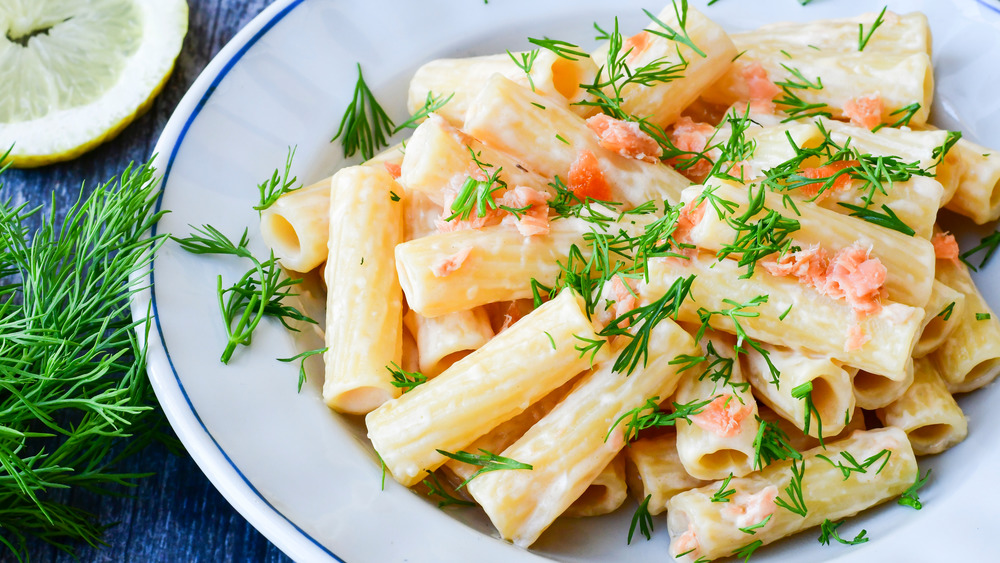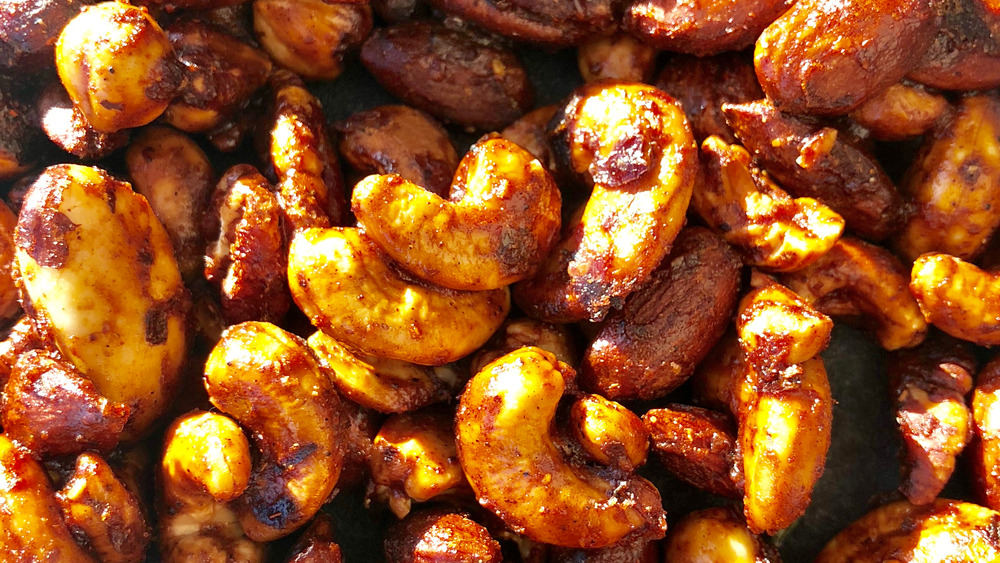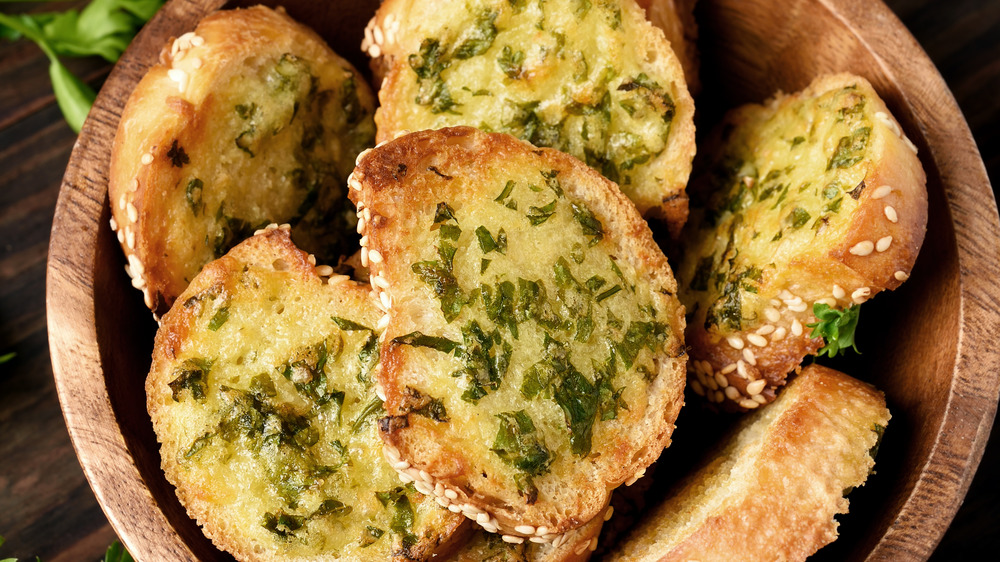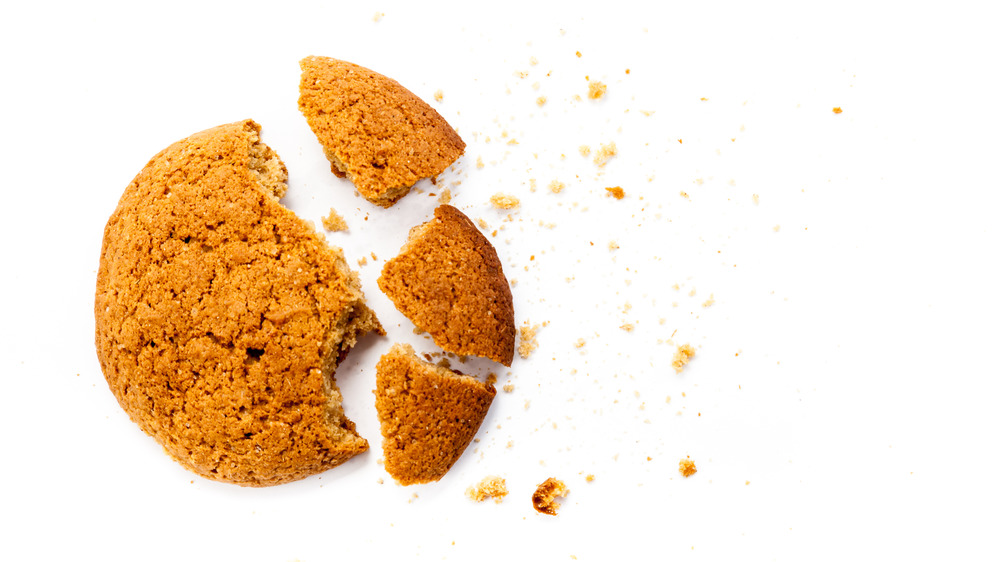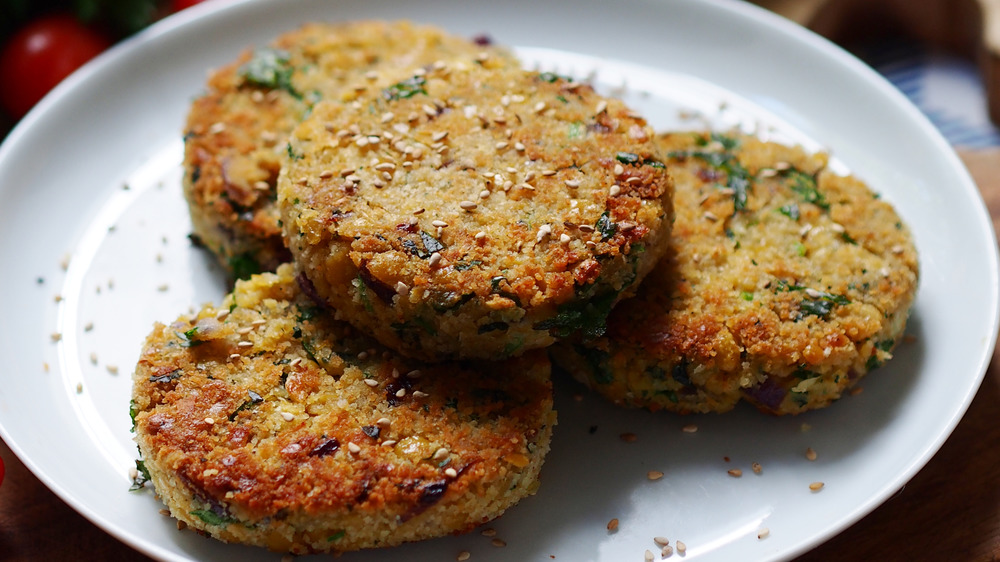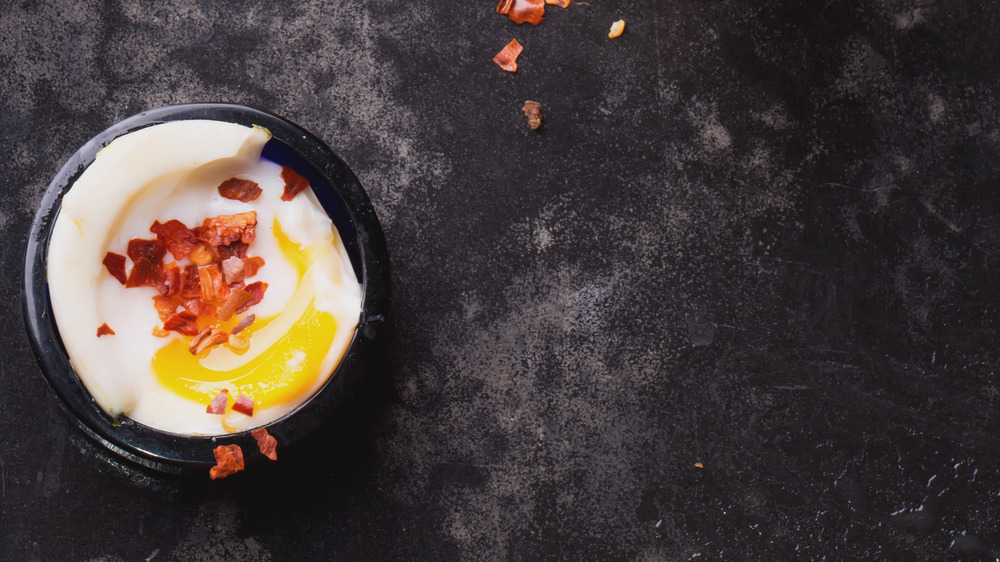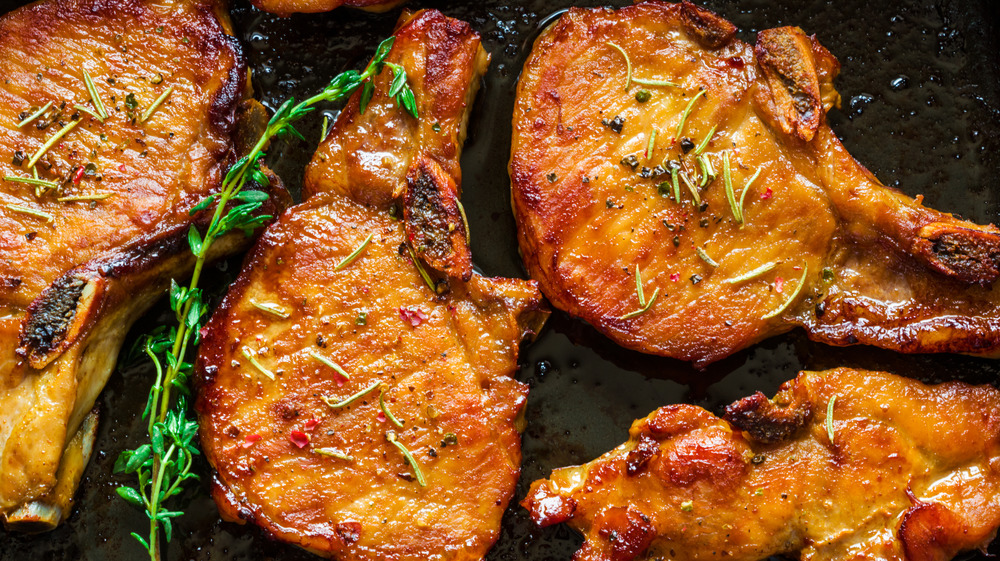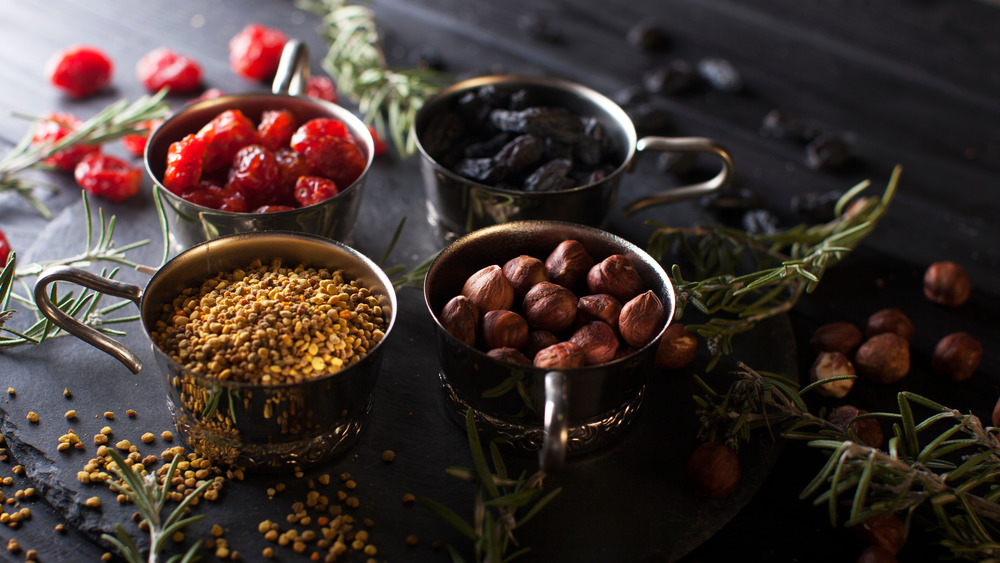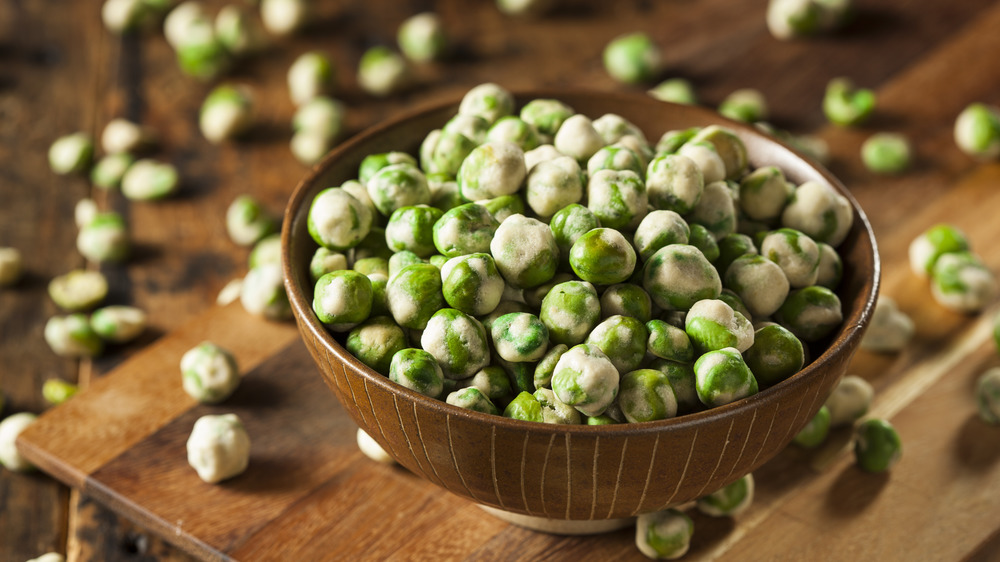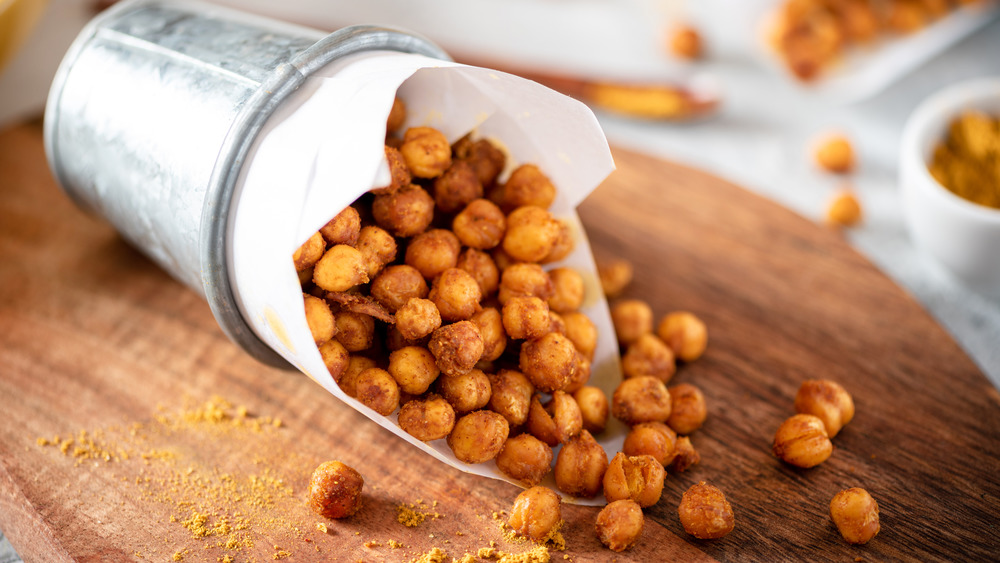If You're Craving Something Salty, Eat These Foods Instead
Having trouble keeping your salt intake in check? You're not alone. The FDA estimates that Americans eat "on average about 3,400 [milligrams] of sodium per day." That's a whole lot more than recommended: The Dietary Guidelines for Americans suggests keeping sodium intake below 2,300 milligrams per day. Nevertheless, nine out of ten people still consume too much salt on a daily basis, according to the American Heart Association. And as delicious as salt may be, it's likely time for you (and us!) to cut back.
Whether you're cutting salt from your diet because your doctor told you it would improve your health or because of articles you've read the hazards of a diet with too much salt or just because you feel better and less bloated without so much sodium in your system, it is possible to live a low-salt lifestyle while still enjoying the stuff you eat each day — including your snacks.
With a little practice and some clever substitutions, you can beat your cravings for chips or fries or pretzels. All you need to do is reach for one of these lower-sodium, healthy— yet still incredibly flavorful — spice-packed foods instead.
Black pepper popcorn is an ideal alternative to the salt-laden snack
As anyone who's ever bitten into a juicy ear of sweet corn during the summer knows, black pepper is a great way to bring out the sweetness of corn, while also making it even more satisfying. The reason for this, according to U.K. spice producer Bo Tree, is that piperine — the substance that gives pepper its bite — creates mild irritation in the mouth that actually makes your food more flavorful.
Because freshly popped popcorn is such a perfect and munchable snack, it's also the ideal vehicle for black pepper. "Black pepper usually goes hand in hand with salt, but adding it [to food] on its own can add just as much flavor without the added sodium," nutritionist Patricia Bannan told Women's Health. And if you spice yours up correctly, you might not even miss the salt.
To make it, just pop some of your favorite salt-free popcorn (either microwave style or on the stovetop) and when it's done, mist it with a bit of olive oil. Then sprinkle some black pepper on top, or grind fresh black peppercorns over the still-warm kernels. Mix well and enjoy.
If you're craving salt, whip up some homemade rosemary potato chips
They say that rosemary is for remembrance, but in the kitchen, rosemary is an ideal and powerful way to infuse your foods with woody, citrusy, evergreen flavor (via MasterClass). Although rosemary works well with a number of different vegetables ranging from tomatoes to carrots to beets, many believe it pairs exceptionally well with the humble potato. The herb gives potatoes, especially roasted ones, a "delightful and aromatic touch" wrote cook and cookbook author Mary Younkin on her site, Barefoot in the Kitchen.
According to Medical News Today, salt cravings often center around snacks. So why not try homemade potato chips covered with rosemary instead of salty store-bought ones? They're a quick, easy, and healthy option for satisfying your salt craving in a responsible — and delicious — way. Although you can make homemade chips in the oven, it's even easier if you have an air fryer.
Taste of Home advises simply cutting a couple potatoes into very thin slices, coating them with a bit of oil, and then air-frying until crisp and golden. Cooking Light has similar recommendations, but they finish their chips by immediately sprinkling them with fresh rosemary as they come out of the fryer. Now that's a snack to remember.
Garlic-coated oyster crackers will ward off a salt craving
When it comes to adding flavor to food without salt, garlic is one of the best options around — this is true whether you're using fresh grated garlic or dried garlic powder. "Spices are a wonderful way to add flavor to your foods so you are less tempted to reach for the salt shaker," Lisa Nelson, registered dietitian, explained in an article for Health Central. Just be sure to stick with garlic powder as opposed to garlic salt, the dietitian noted.
Besides being low in sodium, garlic has also been shown to reduce inflammation throughout the body, improve immunity, and even improve heart health (via Cleveland Clinic).
One easy and ingenious way to make a low-sodium, garlic-covered snack that will satisfy all your salt cravings: Low-sodium or unsalted oyster crackers (the tiny crackers many people put in soup) lightly dusted with a blend of garlic and other spices. Health care company Davita suggests combining garlic powder, complimentary spices (like dill), and a bit of healthy olive oil. Pour the mixture over the crackers and mix until evenly coated. Bake the crackers at 250 degrees Fahrenheit until golden brown.
An easy low-sodium French onion dip can quell stubborn salt cravings
A low-sodium French onion dip is one delicious way to keep salt cravings at bay. Although French onion dip sounds like it could've been dreamed up on the coast of some Riviera beach town, the dish is actually 100 percent American. It was actually called California dip at one point in its history, according to Food52. The dip originated in the 1950s when people started mixing packets of dehydrated Lipton soup mix with sour cream and serving it with chips and veggies.
While the original French onion dip is incredibly high in sodium, it's easy to craft healthier variations. "Making your own French onion dip is a lot simpler than you think," advised The Pioneer Woman. "Simply stir some dried herbs and spices into sour cream, and you have a delicious, addicting snack."
The site's recipe recommends 1 cup of sour cream with an added tablespoon of dried chopped onion and a teaspoon of onion powder along with other spices, like parsley, to taste. Skip the Salt recommends a similar recipe, with a dash of hot sauce to add some heat to your mixture.
Fight your salt cravings with pasta topped with dill
Dill is a misunderstood and underutilized flavor in modern kitchens. Sure, we eat it in pickles and relishes, but it's also the perfect flavor for use in meatballs, on chicken or salmon, or mixed into soups, according to The Kitchn. It's also the perfect alternative to help you fight a salt craving, according to the HeartBright Foundation. Because herbs like dill pack such an intense and concentrated flavor, they're an ideal salt substitute.
You may not have thought of adding dill to your pasta dishes, but consider reaching for this spice instead of the salt shaker. Taste of Home suggested using it in cheesy tortellini or orzo salads, with ravioli, and even in cold summer-style macaroni and seafood salads.
The type of dill you're using impacts the dish's flavor. The Spruce Eats cautioned that fresh dill weed loses its flavor the longer it's cooked, so it needs to be added right before a dish is served. In contrast, dill seeds gain flavor and aroma the longer they are heated, so they need to go into your pasta dish well before serving.
Beat a salt craving with your own homemade cayenne spiced nuts
Similar to black pepper, cayenne powder and its cousin paprika (which combines dried, ground spicy peppers plus sweeter peppers) are ideal alternatives to salt. They're perfect for quelling that craving for sodium without any of the health drawbacks that a diet high in too much salt can cause, such as bloating, high blood pressure, and even an increased risk of stroke (via the American Heart Association).
Both cayenne powder and paprika work well in a number of recipes and make great salt substitutes, registered dietitian nutritionist Patricia Bannan told Women's Health. "[Cayenne] packs a spicy kick, and can add a similar flavor as hot sauce but without the high levels of sodium," she continued.
For an easy and delicious alternative to the salt-doused peanuts and mixed nuts you buy in stores, try making your own blend. Chili Pepper Madness recommends coating plain unsalted nuts with whipped egg whites and then shaking them together with a mixture of cayenne or paprika, plus other spicy seasonings like chipotle powder. Bake the spice-covered nuts at 300 degrees Fahrenheit until golden and nicely toasted.
Try oregano toast to get over a stubborn salt craving
The garlic bread and Texas toast you get in restaurants or pick up in the freezer section in your local grocery store isn't just high in calories, carbs, and fat — it's also loaded with sodium. No wonder it's so crave-worthy when you're jonesing for something salty.
An average slice of Texas toast contains about 300 milligrams of sodium. The salt comes from the bread itself, as well as the butter manufacturers use. Luckily, it's possible to make warm, crispy toast and crostini without a bunch of added salt.
Keeping It Simple recommends brushing a slice of fresh bread with a bit of olive oil rather than butter. Then, place the oiled bread on a cookie sheet, sprinkle some fresh or dried oregano on top of each slice, and cook under your broiler until golden brown. You can also add other herbs like basil or chives — let your imagination run wild!
Chase your salt craving away with the taste of sweet ginger
If you're craving something salty, know that it could just be out of habit. "Many times, the craving for salt stems from a behavioral foundation," celebrity chef and nutritionist Serena Poon told HuffPost. "We crave salt just out of habit or conditioning." Instead of eating something salty, why not try a more exciting flavor? According to the American Heart Association, ginger is one of the top flavors you can add to meals in place of salt.
For a novice foodie, one of the easiest ways to get a hit of ginger is to pick up a package of Ginger Snaps (via American Heart Association). These thin, crisp cookies from Nabisco are relatively low sodium and low in calories; 16 cookies contain just 120 calories. You can also make your own low-sodium ginger cookies. Amy's Healthy Baking offers a recipe that's both low in salt and free of gluten, refined sugar, and refined flour. You can also try the Soft Ginger Lemon Cookies from Sodium Optional, which are completely salt free — and amazing.
If you're craving something salty, try a coriander fritter
If coriander sounds like one of those herbs you've heard of but have no idea what it tastes like, you're in for a delicious surprise — especially if you're a lover of cilantro. It turns out cilantro and coriander are from the same plant! In the United States, cilantro is the name we use for the plant when it's fresh; coriander is the name for the seeds the plant produces (via HuffPost).
As with many herbs, coriander works well as a salt substitute because of its unique, potent flavor (lemony and floral), which enhances the taste of food it's cooked with, without the need for additional salt. While there are countless ways to use coriander in recipes, homemade fritters are a great snacking option involving the spice. Food.com's recipe for zucchini, corn, coriander fritters are perfect for a healthy late-night binge.
Spicy eggs are an ideal solution to an early morning salt craving
No matter when your salt craving hits, a plate of spicy scrambled eggs is the perfect antidote. Cravings for salt can be caused by a number of issues — lack of sleep, PMS, exercising too much, et cetera. Whatever the cause of your salt craving, eating whole, identifiable foods such as eggs is one good way to fight these cravings, the Cleveland Clinic advised. Researchers at the clinic also recommended eating spicy foods to combat salt cravings, since chiles and ground peppers stimulate the brain and make food pleasurable, much like salt does.
For one powerful craving-busting option that combines both of these medically endorsed strategies, try sprinkling red pepper flakes or ground cayenne pepper on scrambled, sunny-side-up, or hard-boiled eggs. The added protein in the egg will fill you up in case it's hunger that's triggering your craving, while the red pepper flakes will up the flavor, making your eggs that much tastier and even more appealing. Take that, salt!
Banish salt cravings with thyme
As far as spices go, thyme has one of the longest and most colorful backstories. Going back thousands of years, it's been considered an antidote to poison, a potent healing compound, and even a tool for chasing away evil spirits and purifying temples (via History).
In a list of the best herbal replacements for salt, the National Heart, Lung, and Blood Institute included thyme as one of their most recommended options, saying the spice should be used widely in "salads, vegetables, fish, and poultry."
Really, thyme goes well with pretty much everything. The U.S. Department of Veteran Affairs recommended many ways to use the herb as a substitute for salt — including mixing it in with green beans, potatoes, beef, pork, and eggs. You may also want to consider mixing thyme with other herbs to keep on hand for quickly seasoning veggies and meat. "For a general all purpose blend, mix garlic and onion powders with basil, thyme, parsley, sage, savory, mace, and black pepper," the department advised.
If you're craving something salty, create your own custom spicy trail mix
When it comes to snacking — and the salty foods people crave most often — Chex Mix has it all. There's a variety of nuts, pretzels, bagel chips, butter, Worcestershire sauce, seasoning salt, and more. However, one serving of General Mills' Traditional Chex Mix contains 460 milligrams of sodium per cup. Many trail mixes are no better, again containing salty nuts plus all kinds of mix-ins, many of which are highly processed and filled with sodium, according to Consumer Reports.
To find a low-sodium prepared trail mix, look for varieties containing unsalted nuts and dried fruits with few other additions. Alternatively, you could make your own. To Taste created a "base" trail mix recipe that includes your choice of seeds and nuts (which you toast yourself for added flavor — make sure all are low sodium) plus dried fruit. From there, you can add allspice, cinnamon, clove, cardamom, nutmeg, ginger, chili powder, cumin, turmeric, or other spices. To make the trail mix, simply dump all your ingredients together in a bag, shake, and start nibbling. Your salt craving won't know what hit it.
Beat your salt cravings with homemade wasabi peas
Wasabi isn't just good for sushi. Its pungent flavor makes it an ideal substitute for salt, packing the intense punch of flavor you're craving without the health risks of ODing on sodium. When it comes to snacking, wasabi peas — which originated in Japan — are a tasty option. Unfortunately, store-bought wasabi peas are also often loaded with salt. Just an ounce of Whole Foods wasabi peas, for example, contains 217 milligrams of sodium, more than a third of your recommended daily intake.
Luckily, making homemade low-sodium wasabi peas is simple. Just be sure to stick with wasabi powder, as wasabi paste can be quite high in sodium (via WebMD). While some recipes suggest buying dried peas, soaking them overnight, and then roasting them, the easiest option is going frozen. Just buy a bag of frozen peas, dump the peas into a bowl, coat them with dried wasabi powder and optional spices, and bake them on a lined cookie sheet at 325 degrees Fahrenheit until nicely toasted (via Splendid Bites). Healthy, low calorie, and delicious!
Skip the salt and go for curry chickpeas instead
Air fryers have changed American kitchens forever. The Cleveland Clinic estimates that using one can help to reduce calorie content of a meal by 70 to 80 percent. And while there are definitely some things you should never cook in an air fryer, chickpeas are thankfully A-okay.
Air-fried chickpeas are a relatively new trend in the world of health food, with numerous outlets such as Eating Well singing their praises. Best of all, they're also an ideal option for busting a salt craving. Making air-fried chickpeas is also incredibly easy. Simply buy a can of chickpeas, drain and rinse, and then allow the peas to dry between paper towels on your counter for at least 30 minutes.
Next, toss them with some olive oil, nutritional yeast (for added breading and crunch), and a salt-free blend of spices of your choice (via AllRecipes). Paprika, cumin, cinnamon, and curry are all good options. Once they're covered in spice, air-fry the chickpeas at 350 degrees Fahrenheit for around 20 minutes or until nicely toasted, tossing every few minutes to prevent burning.

